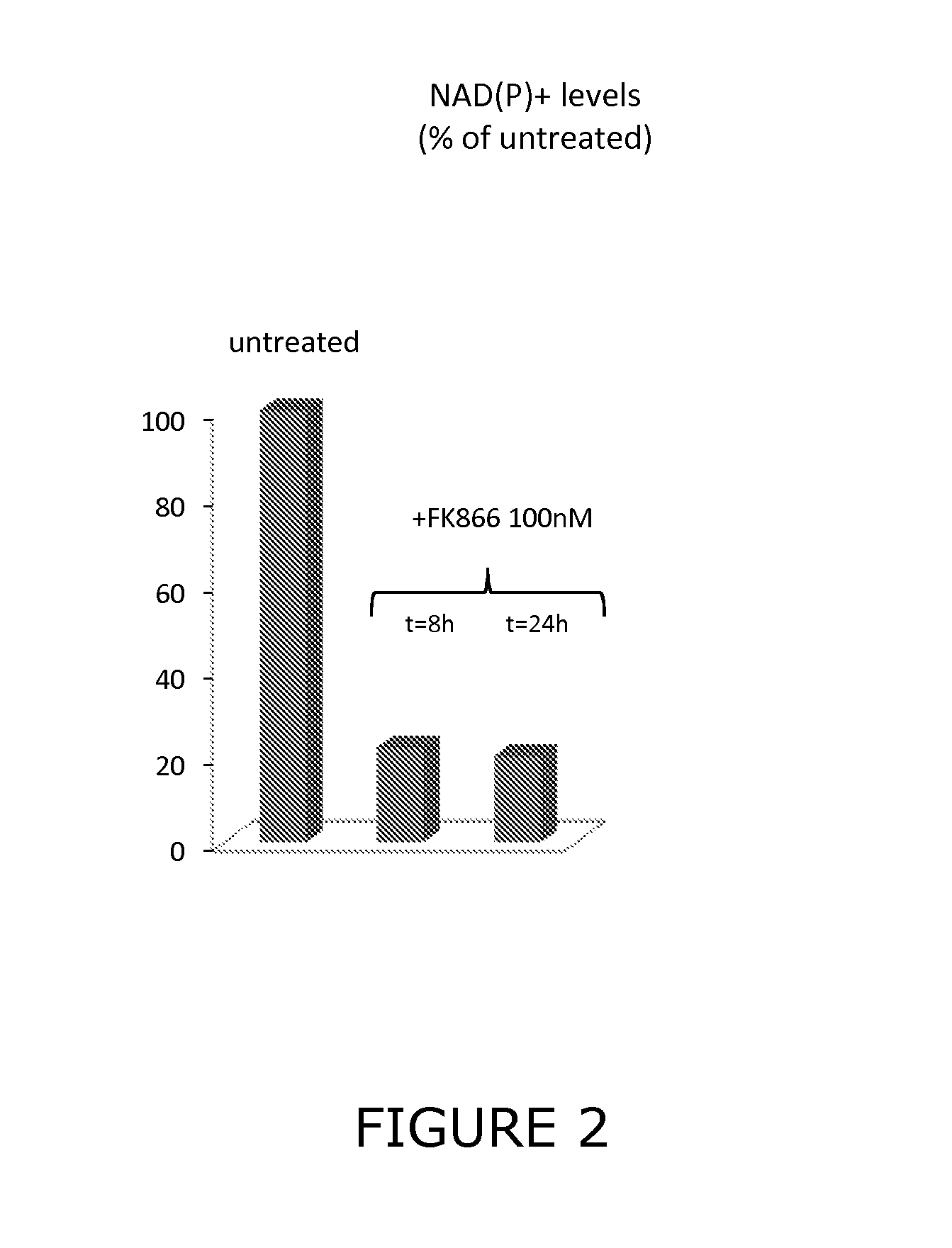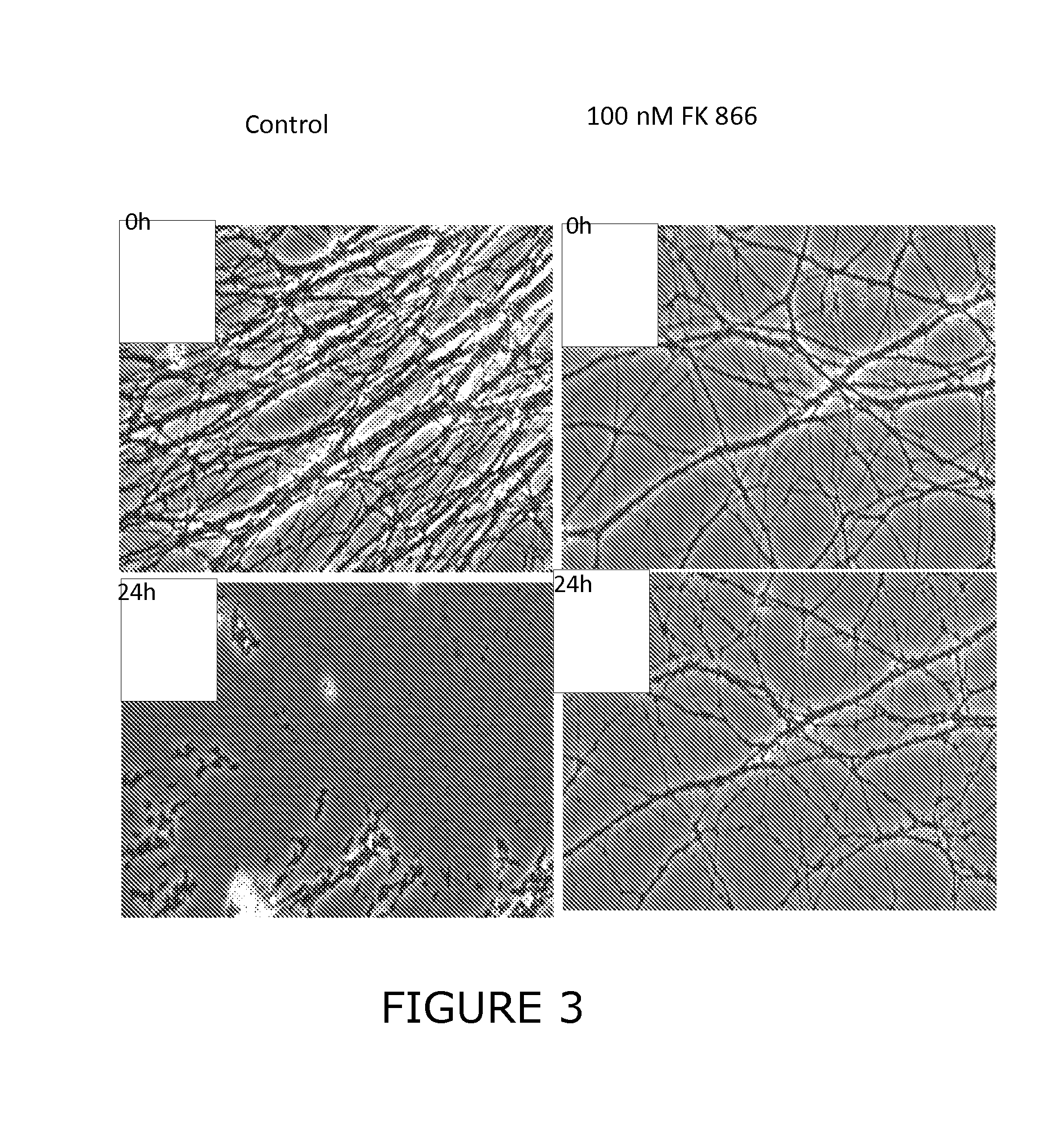Nmn modulators for the treatment of neurodegenerative disorders
a neurodegenerative disorder and nmn technology, applied in the field of nmn modulators for the treatment of neurodegenerative disorders, can solve the problems of loss of the axon distal to the lesion site, neuropathic pain, and intact proximal portion
- Summary
- Abstract
- Description
- Claims
- Application Information
AI Technical Summary
Benefits of technology
Problems solved by technology
Method used
Image
Examples
example 1
Effect of Nampt Inhibitor FK866 upon NAD Levels
[0093]This experiment analysed the effect of the Nampt inhibitor FK866 upon intracellular NAD(P)+ levels. In this experiment, FK866 (1-100 nM final concentration) was applied and the cultures were kept 8-72 hours in the presence of the drug. At this time, the explants were collected in 100 μl H2O for NAD(P)+ determination as described in Billington et al. (2008) J Biol Chem 283(10), 6367-6374.
[0094]The results of this analysis can be seen in FIG. 2. It is known that FK866 is a potent inhibitor of Nampt which would therefore result in a reduction in the intracellular levels of the product NMN+. The results of this study clearly demonstrate that Nampt inhibition also results in depletion of NAD+ further along the NAD+ salvage pathway (as shown in FIG. 1). Therefore, the reduced intracellular levels of NMN+ result in a reduction in the turnover of NMN+ to NAD+ by isoforms of Nmnat. FIG. 2 illustrates NAD(P)+ levels (expressed as percent of...
example 2
Effect of FK866 upon Cut Neurites
[0095]This experiment analysed the effect of the Nampt inhibitor FK866 upon cut neurites using the methodology described above. The results are shown in FIG. 3 which demonstrates that FK866 consistently mimics the WldS phenotype, preserving injured neurites in primary culture even if added shortly after cutting. In this experiment, SCG neurons were cultured for 7 days as described in the methodology, then the neurites were separated from the cell bodies by a scalpel, and the distal part of the neurites with respect to the cut was imaged immediately after the cut or 24 hours after the cut. In some SCG cultures, FK866 (100 nM final concentration) was added the day prior to the cut (right panels). The effect was observed to be shorter than for the WldS phenotype, possibly because NAD+ depletion has other negative effects, however, neurite survival was estimated to be increased by four fold in the presence of the Nampt inhibitor FK866.
example 3
Effect of FK866 and NMN+ upon Cut Neurites
[0096]This experiment was performed in an analogous manner to that described in Example 2, with the exception that NMN+ was also added to the cut neurites in combination with the Nampt inhibitor FK866. The results of this study are shown in FIG. 4 where it can be seen that adding NMN+ to bypass Nampt, consistently reverts the protective effect of FK866 to delay Wallerian degeneration.
[0097]The results of these studies provide a strong link between the levels of NMN+ and Wallerian degeneration. For example, inhibition of Nampt with FK866 (known to reduce NMN+ levels) provided a neuroprotective effect upon cut neurites (FIG. 3) and addition of NMN+ to the Nampt inhibitor (i.e. increasing NMN+ levels) reverted the neuroprotective effect.
PUM
| Property | Measurement | Unit |
|---|---|---|
| neurodegenerative disorder | aaaaa | aaaaa |
| pharmaceutical composition | aaaaa | aaaaa |
| affinity | aaaaa | aaaaa |
Abstract
Description
Claims
Application Information
 Login to View More
Login to View More - R&D
- Intellectual Property
- Life Sciences
- Materials
- Tech Scout
- Unparalleled Data Quality
- Higher Quality Content
- 60% Fewer Hallucinations
Browse by: Latest US Patents, China's latest patents, Technical Efficacy Thesaurus, Application Domain, Technology Topic, Popular Technical Reports.
© 2025 PatSnap. All rights reserved.Legal|Privacy policy|Modern Slavery Act Transparency Statement|Sitemap|About US| Contact US: help@patsnap.com



